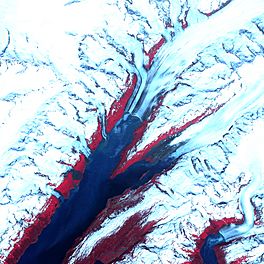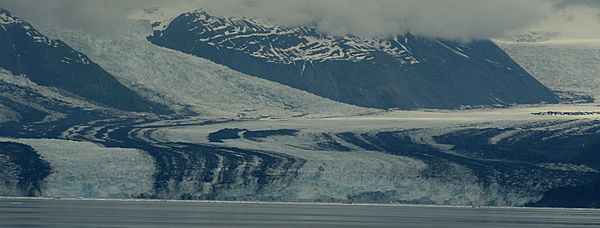Harvard Glacier facts for kids
Quick facts for kids Harvard Glacier |
|
|---|---|

Harvard Glacier is the large glacier at the head of College Fjord. You can see the wide medial moraines in this photo.
|
|
| Type | Tidewater glacier |
| Location | Matanuska-Susitna Borough and Valdez-Cordova Census Area, Alaska, U.S. |
| Coordinates | 61°23′20″N 147°26′11″W / 61.38889°N 147.43639°W |
| Area | 120,000 acres |
| Thickness | 300 ft |
| Terminus | Harvard Arm, College Fjord |
| Status | Advancing |
The Harvard Glacier is a huge tidewater glacier found in Alaska's beautiful Prince William Sound. A tidewater glacier is a special type of glacier that flows all the way into the ocean. The Harvard Glacier has a wide front, about 1.5 miles (2 km) across, where it breaks apart into the College Fjord. It is very thick, about 300 feet deep, and covers a massive 120,000 acres of the Chugach National Forest.
Contents
What is the Harvard Glacier?
The Harvard Glacier is a giant river of ice. It is the second largest glacier in the Prince William Sound. Only the Columbia Glacier is bigger. Glaciers are formed when snow falls and builds up over many years. The weight of the snow turns it into ice. This ice then slowly flows downhill.
Where is Harvard Glacier?
This amazing glacier is located in the state of Alaska, in the United States. It is part of the stunning Prince William Sound area. The glacier flows into a part of the ocean called College Fjord. This fjord is a long, narrow inlet of the sea, often with steep sides.
How Big is it?
The Harvard Glacier is truly enormous. It stretches across 120,000 acres of land. To give you an idea, that's like 90,000 football fields! Its ice face, where it meets the water, is about 1.5 miles wide. The glacier is also incredibly deep, reaching about 300 feet thick in some places. Imagine a 30-story building made of ice!
What is Glacier Calving?
One of the most exciting things about tidewater glaciers is "calving." This is when huge chunks of ice break off the glacier's front and fall into the water. It makes a loud cracking sound, like thunder! These broken pieces of ice then float away as icebergs. The Harvard Glacier is known for its impressive calving events.
What are Moraines?
If you look closely at pictures of the Harvard Glacier, you might see dark lines on its surface. These are called "medial moraines." Moraines are piles of rocks and dirt that a glacier picks up as it moves. When two glaciers join together, their side moraines can combine in the middle, forming a medial moraine. These lines show the path the ice has taken.
Why Do People Visit Harvard Glacier?
The Harvard Glacier is a very popular spot for cruise ships. Many tourists come to Prince William Sound to see its beauty. People love to watch the glacier calve and see the massive icebergs. It's an incredible experience to witness nature's power up close. The area around the glacier is also home to amazing wildlife.


